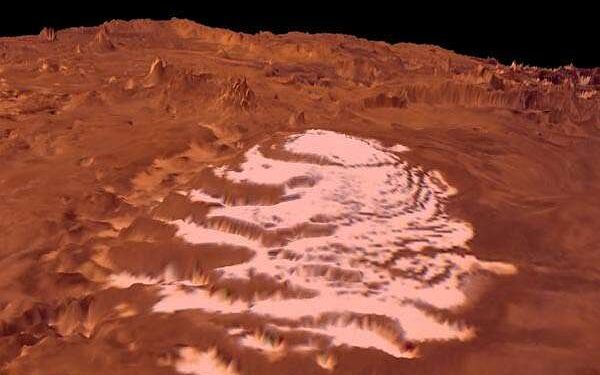
Why the Martian polar caps show significant differences
by Clarence Oxford
Los Angeles CA (SPX) Sep 05, 2024
For centuries, observers have watched the bright poles of Mars change with the seasons. In the last 50 years, scientists have determined that these polar caps are primarily composed of carbon dioxide that cycles in and out of the atmosphere with the seasons. However, the underlying processes driving these changes are intricate and continue to be a focus of scientific study.
In a recent paper published in ‘Icarus’, PSI Senior Scientist Candice Hansen, along with her team, delves into these complexities. The research integrates decades of previous studies with new data from the High-Resolution Imaging Experiment (HiRISE) on the Mars Reconnaissance Orbiter to explore the differences in carbon dioxide behavior between Mars’ northern and southern poles.
“Everybody knows there’s a difference in how carbon dioxide interacts with the poles, but how many people understand why?” Hansen stated. “That was what I was setting out to describe. And fortunately, I have a whole bunch of really talented co-authors who were willing to fill in their own pieces.”
The study aims to illuminate the mechanisms shaping Mars’ surface and its overall climate, as approximately a quarter of the Martian atmosphere cycles throughout the year.
Mars experiences seasons similar to Earth due to its axial tilt of about 25 degrees. However, unlike Earth, Mars’ orbit around the Sun is more eccentric, meaning its distance from the Sun varies more significantly, which affects the length of its seasons. Mars is farthest from the Sun during its southern fall and winter, making these seasons longer and causing the most atmospheric freezing, according to Hansen. This seasonal behavior contributes to the significant differences in how carbon dioxide interacts with the Martian poles.
In contrast, Mars’ northern winter is shorter and coincides with the planet’s dust storm season, resulting in the northern polar cap having a higher dust content, which makes the ice less durable.
“They’re not symmetric seasons,” Hansen explained.
The paper also highlights how the differences in terrain between the northern and southern poles influence the landscape-shaping effects of carbon dioxide ice and gas. For instance, the southern hemisphere features black dust fans across the terrain. During the southern fall, a layer of carbon dioxide ice forms, thickening over the winter and becoming translucent. When spring arrives, sunlight penetrates this ice layer, warming the ground beneath it and causing the carbon dioxide ice to sublimate into gas.
“Now, gas is trapped under pressure,” Hansen described. “It’s going to look for any weak spot in the ice and rupture like a champagne cork.”
This process creates a network of gully channels called araneiforms, which have a spider-like appearance. As the gas breaks through the ice, it releases dark dust into the atmosphere, forming fan-shaped deposits influenced by the prevailing winds.
In the northern hemisphere, similar processes occur, but they are shaped by the region’s sand dunes. When the Sun rises and sublimates the ice layer, weak spots in the dunes allow gas to escape, but the sand’s movement tends to smooth out the terrain, preventing the formation of araneiforms.
Hansen, a member of the HiRISE imaging team, monitors these surface changes on Mars, observing alterations that happen over days, months, and years.
“Most of my colleagues study the changes that happened on Mars 3.5 billion years ago, but I’m talking about things that happened last month,” Hansen said. “Mars is active today.”
Hansen’s research is funded by the Mars Reconnaissance Orbiter Mission’s HiRISE instrument through a subcontract from the University of Arizona.
Research Report:A comparison of CO2 seasonal activity in Mars’ northern and southern hemispheres
Related Links
Planetary Science Institute
Mars News and Information at MarsDaily.com
Lunar Dreams and more
